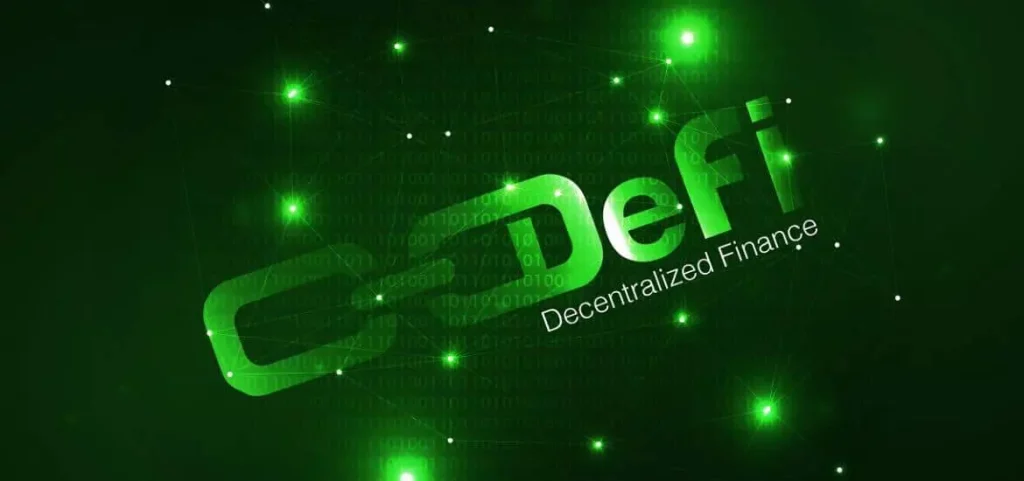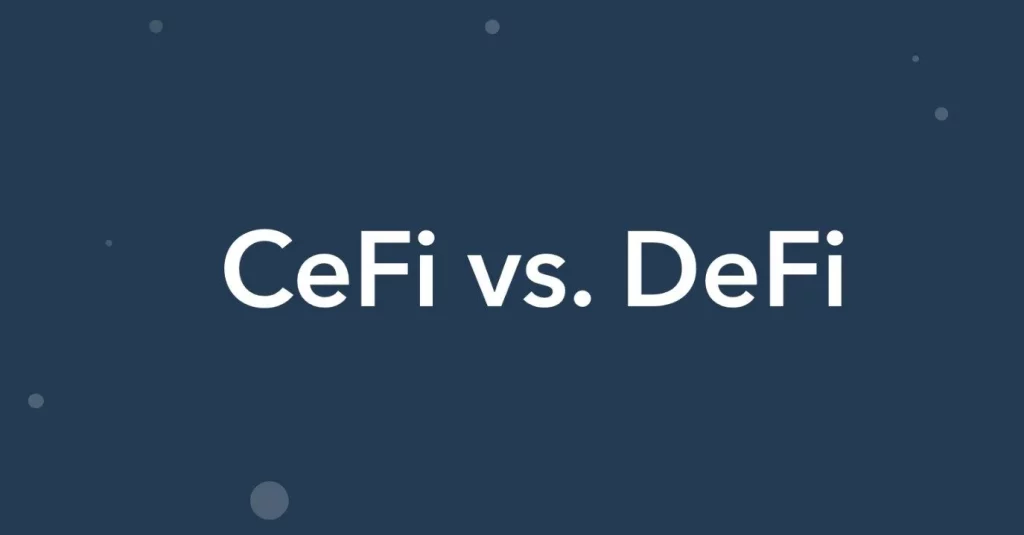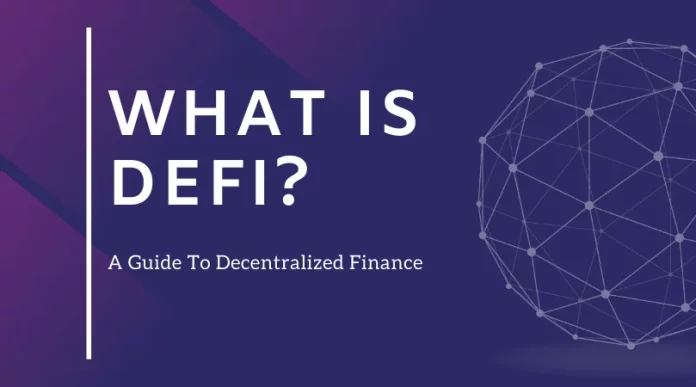
Decentralized Finance, commonly called DeFi, has become a disruptive force in the financial industry. DeFi is revolutionizing traditional banking institutions and empowering people worldwide by enabling open and permissionless access to financial services. In this blog post, BTAguru will examine what DeFi is, how it functions, how it alters the world, its advantages, common use cases, difficulties in adopting it, and its prospects for the future.
What is DeFi?
DeFi refers to a movement that aims to recreate traditional financial systems using blockchain technology. It eliminates the need for intermediaries such as banks and brokers by leveraging smart contracts on decentralized platforms like Ethereum. These smart contracts enable programmable, self-executing agreements without third-party involvement.
To be more specific, DeFi is the “path” that brings traditional financial products to decentralized “land.” The need for third parties is eliminated (or minimized), transparency and safety are enhanced, and costs are reduced, paperless, and intermediary-free.
Currently, Ethereum is the platform with the most active DeFi applications. However, in recent years other ecosystems such as Tron, BNB Chain, Polygon,… also shows strong development.
The Core Principles of DeFi

Openness
DeFi encourages openness by allowing anybody to use financial services without restrictions or discrimination. It eliminates the exclusivity frequently connected to conventional banking systems and offers opportunities to everyone with an internet connection.
Transparency
In DeFi, transparency is a key component. All transactions and activities are documented on open blockchains, where anyone can review them. Participants are more likely to trust one another, and the system is held accountable thanks to this transparency.
Security
By exploiting the built-in security capabilities of blockchain technology, DeFi platforms put security first. Cryptographic protocols create an additional degree of defense against fraud and illegal access. Even though blockchain technology is secure in and of itself, certain applications or smart contracts may nonetheless contain weaknesses.
Interoperability
One of the most important traits of DeFi ecosystems is interoperability. Through standardized interfaces, many protocols and platforms may communicate with one another without difficulty, enabling users to access a variety of services freely.
How Does DeFi Work?
DeFi’s operation depends on blockchain technology, particularly Ethereum. DeFi apps’ building blocks are smart contracts. Once certain circumstances are met, these self-executing agreements immediately take action. Various financial services, including lending, borrowing, and trading, can be carried out unreliable and decentralized using smart contracts.
The Positive Aspects Of DeFi
Financial Inclusion
The unbanked and underbanked population around the world may be able to access financial services because of DeFi. People can now access loans, savings accounts, and investment opportunities previously unavailable or constrained owing to economic or geographic constraints with an internet connection.
Lower Costs
DeFi drastically lowers transaction fees and operational costs associated with conventional financial systems by avoiding middlemen like banks and brokers. Individual users gain from the cost savings, and organizations can optimize their operations more effectively thanks to it.
Enhanced Security
Using blockchain technology in DeFi enhances security by removing single points of failure and reducing the risk of fraud or manipulation. The transparency and immutability of transactions on the blockchain make it difficult for bad actors to manipulate records or engage in fraudulent activities.
Innovation and Flexibility
DeFi fosters innovation by providing an open playground for developers to create new decentralized applications (DApps) and experiment with novel financial instruments. This flexibility allows for rapid iterations and advancements in financial technology.
Accessibility
Financial services are made available to everyone through DeFi, regardless of location or socioeconomic standing. DeFi applications are accessible to anyone with an internet connection, even individuals who have traditionally been denied access to traditional banking systems.
Global Reach
Since DeFi operates on a decentralized network, it is not restricted by geographical boundaries or national regulations. Anyone with an internet connection can participate regardless of their location or nationality.
How DeFi Is Being Used Now
Decentralized Exchanges (DEX)
Decentralized exchanges enable peer-to-peer trading without relying on centralized intermediaries. Users can trade cryptocurrencies directly from their wallets while controlling their funds.
At the moment, the majority of Bitcoin users trade on controlled exchanges like Coinbase or Gemini. DEXs enable peer-to-peer financial transactions while allowing users to maintain ownership of their funds.
Stablecoins
Stablecoins are cryptocurrencies pegged to a stable asset, such as the US dollar. They provide stability and reduce the volatility typically associated with cryptocurrencies, making them suitable for everyday transactions and lending purposes within the DeFi ecosystem.
Lending and Borrowing
DeFi platforms offer lending and borrowing services without requiring a traditional bank as an intermediary. Users can lend their crypto assets to earn interest or borrow against their holdings by collateralizing them with other digital assets.
Yield Farming
Yield farming involves users providing liquidity to DeFi protocols in exchange for rewards or additional tokens. By staking their cryptocurrency assets, users contribute to the liquidity pool, which allows others to trade on decentralized exchanges more efficiently.
Decentralized Insurance
DeFi has also paved the way for decentralized insurance platforms, where participants can protect themselves against risks by contributing to a common pool. These platforms operate autonomously using smart contracts, eliminating the need for intermediaries and reducing costs.
Non-fungible tokens (NFTs).
NFTs create digital assets out of typically non-tradable assets, like videos of slam dunks or the first tweet on Twitter. NFTs commodify the previously uncommodifiable.
E-wallets.
DeFi developers are creating digital wallets that can operate independently from the largest cryptocurrency exchanges, providing investors access to a wide range of options, including cryptocurrencies and blockchain-based games.
Flash loans.
Check it out! These cryptocurrency loans are wild. They let you borrow and repay funds all in one shot. Sounds crazy, right? But here’s the deal: You can get in on this action by signing a contract on the Ethereum blockchain. No need for fancy lawyers or anything. It borrows the funds, does the transaction, and boom – the loan is repaid instantly. No worries if things go south and the transaction can’t happen or leaves you in the red! The money automatically goes back to the lender. And hey, if you make some sweet profit, you can totally keep it (minus any interest or fees). It’s like doing decentralized arbitrage with these flash loans. Pretty rad?

Risks and Downsides of DeFi
While DeFi presents numerous opportunities, there are also challenges that need to be addressed for its widespread adoption.
- Scalability: Blockchain networks face scalability limitations, causing congestion and high transaction fees during peak usage.
- Regulatory Uncertainty: The regulatory landscape surrounding DeFi is still evolving, creating uncertainty for developers and users.
- Smart Contract Risks: Vulnerabilities in smart contract code can lead to exploits or hacks, resulting in financial losses.
- User Experience: DeFi applications can sometimes be complex and challenging for non-technical users to navigate.
The motivation for DeFi’s creation
In CeFi (Centralized Finance*), you trust the government not to print money unexpectedly for inflation to soar; banks will keep your money safe; And you often make a profit by entrusting your assets to a third party, which means giving control of your money to someone else.
*CeFi: Traditional finance/centralized finance
But you have to agree that even if it’s your money, you can’t have complete control over it in any of the abovementioned ways. DeFi was created to establish an inclusive financial system accessible to all individuals. In this system, people can exercise full control over their assets. More broadly, using blockchain technology, DeFi aims to decentralize key aspects of traditional finance, including trading, lending, investing, asset management, payments, and insurance. So could DeFi potentially replace CeFi in the future?
Can DeFi replace CeFi?

Basically, DeFi will not be able to replace CeFi completely. However, they will provide more services that CeFi cannot provide.
In DeFi:
- Cryptocurrencies will replace assets
- Organizations, states, and companies will be replaced by Blockchain
- Wherever you are, you only need a device connected to the Internet to access decentralized finance
As such, DeFi tools are certainly different from CeFi tools, even though they offer similar financial services, such as loans.
Not only that, but they also offer brand new financial services such as stablecoins (DAI, True USD,…)
The Future of DeFi
DeFi’s future is promising thanks to cutting out the middlemen and creating digital assets with a market value out of basketball clips. DeFi is still in its infancy regarding capabilities, but professionals like Dan Simerman, head of financial relations at IOTA Foundation, a DeFi research and development group, view its promise and potential as far-reaching.
Investors’ independence will increase shortly, enabling them to “deploy [assets] in innovative ways that seem impossible today,” according to Simerman. According to Simerman, DeFi has significant ramifications for the big data industry as it develops and allows data to be sold in new ways.
Despite all of its potential, DeFi still has a long way to go, particularly in terms of popular acceptance.
“The promise is there,” says Simerman. “It’s up to us to continue educating people about the potential, but we also need to keep working hard to build the tools to allow people to see it for themselves.”
Conclusion
Decentralized finance has become a disruptive force in the financial sector, upending established banking structures and empowering people worldwide. It provides several advantages, including financial inclusion, cheaper costs, improved security, innovation, and accessibility, thanks to its key principles of openness, transparency, security, and interoperability.
DeFi is revolutionizing how we interact with financial services through various use cases, including decentralized insurance, stablecoins, lending/borrowing platforms, yield farming, and decentralized exchanges. Despite difficulties with scalability and regulatory ambiguity, DeFi is still evolving quickly and has the potential to impact many different areas of the global economy significantly. The future of DeFi is bright as it reshapes the finance industry as we know it, thanks to continued technological breakthroughs and growing usage globally.


